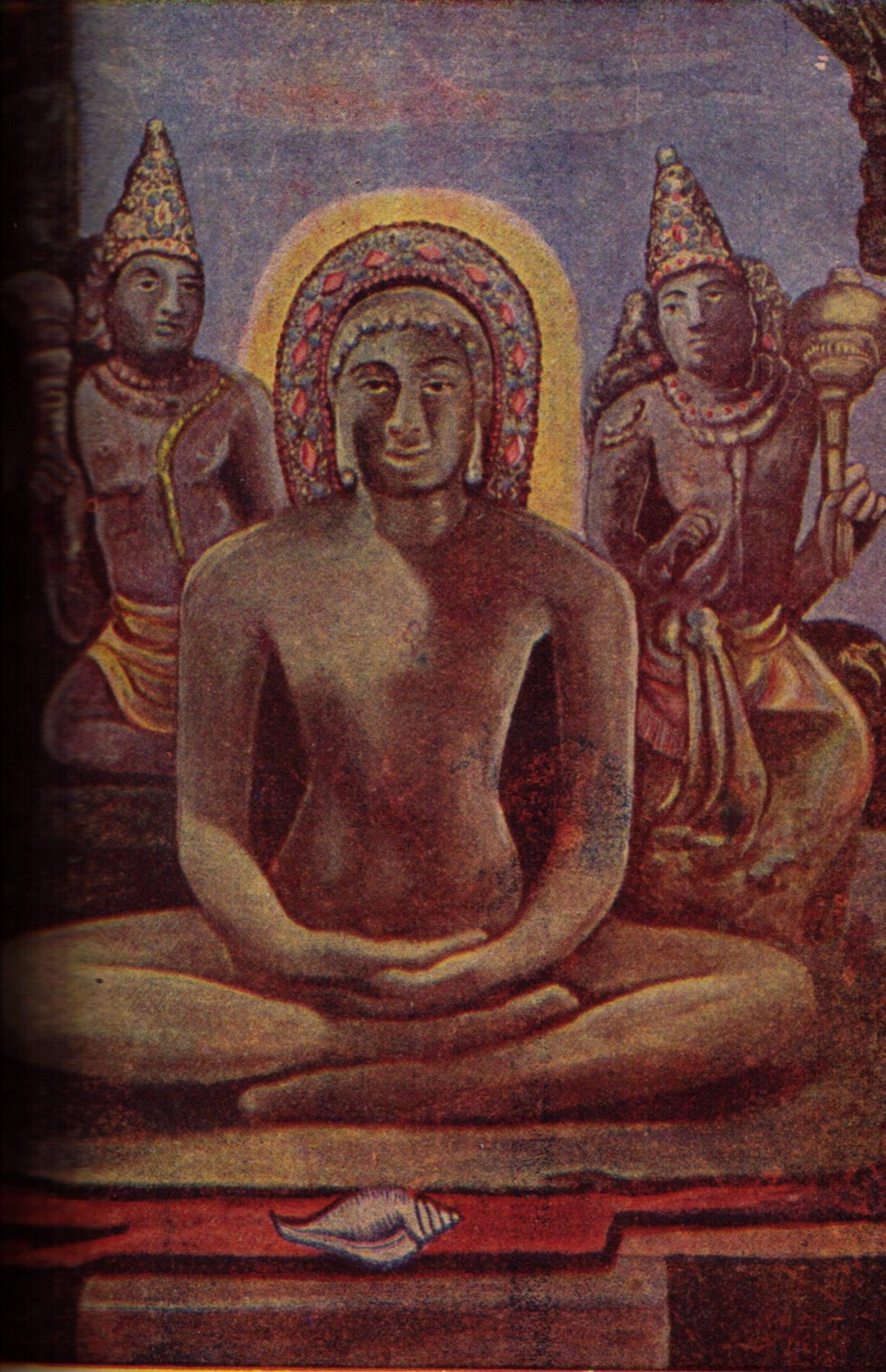
The paper was published in The Voice of Ahinsa - The Indo-German Special Number (Vol. VI, No. 10 - October 1956, pp. 408ff.).
Buddha and Mahavira
Buddha and Mahavira; These are not merely two systems to be classified as such among the various manifestations of human thought, they are also two distinct human natures, which often have been inimically opposed to each other and yet are united by the common striving for highest values, for all that is sublime and good. From the bottomless depth of his soul the Buddha reveals ideas and symbols of superworldly beauty and huminosity; practical and ordering the Jina builds up a solid system which lovingly takes care of even the minutest thing.
It is essential to bear in mind that any philosophical system is but the rationally presentable outcome of the particular psychology of the individual, and a proper estimate can only be made if we do not merely cling to the surface but go to the very bottom and source from whence the philosophical structure has grown. When we reflect upon the history of human thought, we see that one individual is orientated by objective data, while another individual is orientated by the inner processes by the subject. Neither of them can understand the other because each one views the other from his particular standpoint which necessarily excludes any other standpoint. Therefore also no value can be attached to the so-called refutations that are alleged to have taken place several times in history. It should better be borne in mind that a so-called refutation is but the assertion of one's failure to have understood the other's viewpoint and is the rationally more acceptable term for self-deception by wilful ignorance. Moreover, it would be too easy and too cheap to view the difference that certainly exist between the teachings of Buddha and Mahavira merely from a polemical standpoint.
The lives of these two great men are too genuine to be dealt with in a manner that might suggest that the one is the misunderstanding of the other. Each one has contributed to the solution of man's problems and each one has appealed to that group of human beings which share that particular attitude by which the lives of either one were regulated. Therefore both Buddha and Mahavira have more in common than their divergent doctrines, as handed down to us in often only dead letters, might lead us to suppose, for none of them pretended after the manner of ambitions and vainglorious people that there was, anything original in their teachings. In fact both maintained that they were merely leading humanity, which in time had become formalized, back to its own basic and initial insight and wisdom. Both of them had the highest respect for knowledge, which was not the cause of sin and ugliness as in non-Eastern religious systems but the indispensable and unique means for attaining liberation - moksha; nirvana.

Two Types
Nataputta Vardhamana Mahavira, the last in a line of twenty-four Tirthankaras of whom only the twenty-third, Parshva, can claim to be a historical personality, was born at Vaisali near Patna. He was a Kshatriya of the clan of the Jnatras. When he was thirty years of age, he became a monk. He practised severe austerities for twelve years, after which he found enlightenment and became a Kevalin. He then preached and lived his doctrine for fourty-two years and attained moksha a few years before Buddha's entering Parinibbana.
According to the Christian Era this event would have taken place either 477 or 476 BCE. Siddhartha Gautama Buddha was born on the Lumbini Gardens which are situated just over the modern border of the Nepal Terai. He was a Kshatriya of the clan of the Shakyas. He was married and had one son. At the age of twenty-nine he left his home in search for liberation. Having first practised severe austerities but not having attained his goal by them, he gave up this course of life and studied with various teachers. But having seen the poverty of mere philosophic learning, he also rejected it and invoked against it the testimony of his own inner world. After deep meditation he became the Buddha, the Enlightened One, at the age of thirty-five. For forty-five years he preached and lived the message he had to tell and in 483 BCE he entered Parinibbana.
However scanty the record of the lives of Buddha and Mahavira may appear, yet they yield sufficient evidence of the fact that both men represented two different types. The one attaches great value to the practice of austerities and his foundation in life is the relation to objective data, while the other rejects this course as being absolutely opposed to his very nature and is grounded on the inner realities.
In a small essay like this it cannot be the task to point out in detail where Buddha and Mahavira differ from each other and where they are in harmony with each other. The main point is to show that, whatever the harmonies or divergences may be both men here had and still may have great importance for the cultural and spiritual development of mankind. And this may be shown by the interpretation of the idea of karman which both Mahāvira and Buddha acknowledged as being of tremendous importance for the life of man.
Karman
According to the Jainas the Karman is something concrete that attaches to the soul and thereby veils and as it were, disfigures its true nature. It is through our actions that we produce what is technically termed bkavakarma which then becomes the so-called dravyakarma. This flows into the soul, infects it in the true sense of the word, and owing to this "infection" the soul is fettered. The true nature of the soul can manifest itself only, when we succeed in preventing the infection of the soul by new Karman and in removing the Karman which has already entered the soul, before it bears its disastrous effect. This is done by leading a virtuous life, which blocks the way to bad Karman, and is technically known as samvara. The extirpation of Karman is achieved by austerities and technically known as nirjara. When the soul has been purified of all Karman it attains its true nature and enjoys the bliss of liberation. From this short summary it is evident that the objective rather than the subjective value plays the greater role as the determinant factor in man's life. Thus the actual fact of whatever the case may be is decisive for the production of Karman and for the ensuing results. In this way, action can be described in concrete terms as an ethical behaviour.
For the Buddhists, on the other hand, Karman is but a short-hand term for the intensity of the energetic certain process that becomes manifest in certain operations or effects. The decisive factor is not so much the action itself but the motivation to the particular action. The liberation from Karman can only come about when amount of energy that is spent in the world by an individual has been achieved and thereby also a change of attitude. Then turbulence of a mind engaged in worldly matters, lashed by the storm of sense perceptions, has subsided to the quiet peace of an unruffled sea, out of which once the turbid waves arose and into which they faded back again. Thus not the objective fact is decisive, but what stands behind the action. And who stands behind it? - Man; the subject.
Wider Gulf
There can hardly be a wider gulf between two views than the one here presented. And yet the one is as real as is the other. Whereas the one refers preeminently to that which reaches him from the object, the other relies upon the subjective deposition. This subjective factor cannot be ignored and can claim as much validity as the objective data. He who relies upon the objective data develops in width. He includes in his view of life and in his mode of action the whole animate and inanimate world, while he who relies upon the subjective factor develops into depth. He sees the becoming and the passing of things beside their momentary present existence and he also sees that which was there before things came into being and which will be after they have passed hence.
Thus Mahavira and Buddha represent two "weltanschauungen'' which for practical purposes well harmonise with each other. But, more than that, Buddha and Mahavira are Teachers from whom present day humanity may learn with profit. In an age where hatred and suspicion poisons the relationship between man and man, between nation and nation, where the cry for rearmament and the mad lust for inflicting untold suffering on others drowns all softer sounds of love and kindness, the Jaina's insistence on the sacredness of all that is alive, on taking joyous participation in all that is good and sublime in others instead of harping on other people's defects, might do the world quite a lot of good. So also the Buddha's wisdom that true spirituality is only found when the slightest vestige of self-adoration and self-glorification is wiped out, might come as a timely remedy to an age of spiritual hollowness.
 Herbert V. Dr. Guenther
Herbert V. Dr. Guenther